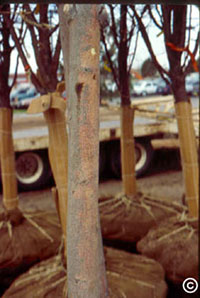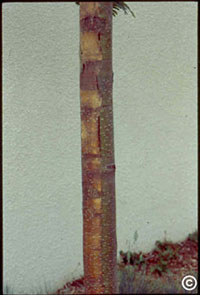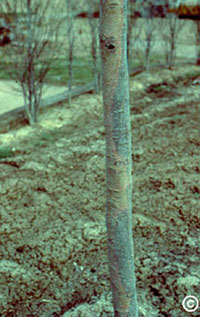
Sunscald is often called southwest injury because it most often occurs on the southwest side of young tree trunks.
When does sunscald occur?
In Colorado, sunscald primarily occurs from December through March on young, thin-barked, deciduous trees. In other parts of the country where winter temperatures remain cold and where cloudy, sunless days prevail, sunscald occurs less frequently.
What causes sunscald?

Photo Credit: CSU Extension
High-intensity sunlight during winter, which occurs at a lower angle in the sky, heats up the south and southwest side of deciduous tree trunks, which causes cells to come out of dormancy and become active. After sunset or as weather changes, temperatures may drop below freezing, and this temperature drop kills active cells and conductive tissue. Later, this injury may appear as sunken and discolored bark. This bark may crack or fall off in patches later, revealing dead tissue underneath.

What trees are at risk for sunscald?
Young, thin-barked deciduous trees, such as honey locusts, fruit trees, ashes, oaks, maples, lindens, and willows are at the highest risk.
How can I prevent sunscald?
Commercial tree wraps made of crepe paper insulate bark and are an effective way to prevent sunscald. In late October or early November, wrap trunks upward from the base of the tree to a point just above the lowest branches. Overlap about 33 percent with each turn. Secure the wrap with tape, but be careful not to attach the tape to the tree bark. Be sure to remove tree wrap and tape the following April to avoid girdling and possible insect damage. You may need to wrap trees each winter for several years until bark thickens and is less prone to sunscald damage.
Orchardists often whitewash or paint tree trunks white to reflect winter sunlight. While this is an effective way to prevent sunscald, it’s more aesthetically acceptable in an orchard than in the urban landscape.
Source: CSU Extension

